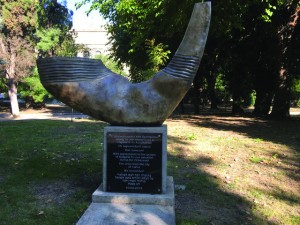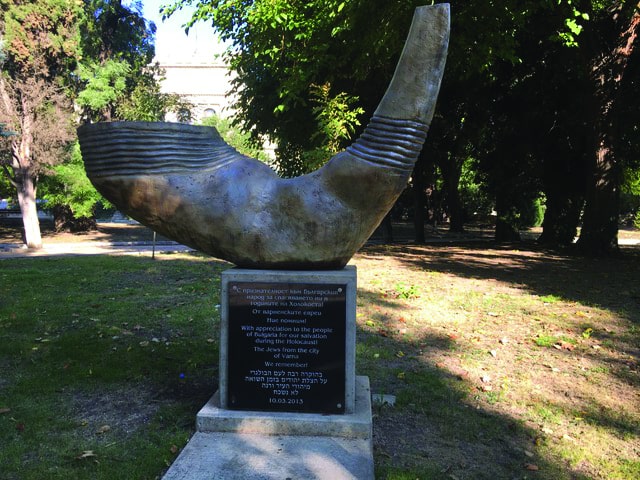 Prue Salasky spent six months of a 10-month teaching assignment in Bulgaria through the U.S. Fulbright program. Her Balkan adventure, including plans to visit Istanbul, Kiev, Odessa, and Israel, was cut short when Fulbright canceled all its programs worldwide due to the novel coronavirus pandemic and sent everyone home—effective immediately. Salasky was in Baltimore, Md, at the time, attending her daughter’s wedding when her foray into Eastern Europe was abruptly over, with no time to return for goodbyes or even to collect her belongings.
Prue Salasky spent six months of a 10-month teaching assignment in Bulgaria through the U.S. Fulbright program. Her Balkan adventure, including plans to visit Istanbul, Kiev, Odessa, and Israel, was cut short when Fulbright canceled all its programs worldwide due to the novel coronavirus pandemic and sent everyone home—effective immediately. Salasky was in Baltimore, Md, at the time, attending her daughter’s wedding when her foray into Eastern Europe was abruptly over, with no time to return for goodbyes or even to collect her belongings.
She returned home to Norfolk and started the readjustment to U.S. life in the COVID-19 era.
The first installment of her experience in Bulgaria was published in the December 14, 2020 edition of Jewish News. This is the second and final piece.
Jewish life In Sofia
Seventy years later, the remnants of Bulgarian Jewish life are largely confined to Sofia, where there’s a community center helped by American Jewish Joint Distribution Committee funds and the Ronald S. Lauder Jewish School, which opened in 2019. Together, they complement the Sofia Central Synagogue, a glorious Moorish Revival style building designed by Austrian Friedrich Grunanger to accommodate 1,300 worshipers, and whose 1909 dedication was attended by Tsar Ferdinand 1 and his wife. However, despite the community’s post-Soviet revival—at its rededication in 1996, the mayor of Sofia and other dignitaries attended—and the attendance of hundreds for Hanukkah celebrations, according to volunteer guide Leon Benatov, the Orthodox shul cannot always raise a minyan for Friday night services.
When cousins Marilyn and Ken Siegel from Virginia Beach met me in Sofia in mid-February, we called the synagogue in advance to identify ourselves. On arrival, we were admitted and entered a small side chapel; there, Marilyn and I were ushered to the back to follow the Kabbalat Shabbat service from behind view-blocking lace curtains. Meanwhile, Ken sat with a handful of men of varying ages as we all listened anxiously for the arrival of enough men to form a minyan; it was close to 30 minutes after the designated time for services until a sufficient number of men had gathered. The Israeli rabbi, on staff since 2016, proceeded to race through the prayers at breakneck speed using a siddur with Hebrew on one side of the page with Bulgarian facing.
We returned on Sunday morning for a tour of the main sanctuary, a truly spectacular and elaborate interior from the turn of the 20th century when many of the extant synagogues in the Balkans were built, a testament to the general prosperity of Bulgaria’s most recent ‘golden age’ and the comfortable place held by Jews in that society. The guide, Leon Benatov, pointed out a corner of the sanctuary’s floor damaged by an aerial Allied bomb. He was one of those saved during WW II, when in June 1943 his family, like all 25,000 Jewish residents of Sofia, were dispersed to 20 towns in the countryside for their protection. His family stayed in one room in another Jewish family’s home in Provadia, a small town near Varna, the country’s largest port on the Black Sea. Then five years old, Leon recalled the hunger and difficulties of the family’s 15-month exile, but also noted that he, his parents and sister stayed together (his father being over 45 was exempt from the labor camps), and it providentially saved them from the Allied bombing of Sofia. They were also fortunate to return to their home—and eventually were even able to reclaim most of their belongings. After the war, he remembers receiving packages of clothes and food from the JDC.
Now 82, Leon, many of whose family were among those making Aliyah after the war, is working to preserve the history and legacy of Jews in Bulgaria. He recently translated a history by Avram Takhzher from Ladino to Bulgarian, a book I purchased (at some expense!), but which was a casualty of my unexpected departure from the country. He has almost completed a book of 3,200 Jewish proverbs in Ladino with a Bulgarian translation; and he’s preparing a reprint of a four-volume Israeli series featuring the biographies of 137 prominent Jews in Bulgaria.
Leah Davcheva, in her mid-60s, is also involved in preserving the heritage of the country’s Ladino speakers. She has interviewed more than a dozen in Sofia (some of whom have passed since she began the project) in Bulgarian for an ethnographic study slated for publication in December 2020. She grew up nonobservant in a Jewish community of about 200 in Ruse (Roo-say) on the Danube with parents who were both Communist Party members. They were Ladino speakers, but Leah never learned the language. She and her husband settled in Sofia in the ’70s, but she still considers herself an outsider in its religious community.
Synagogues but no services
Beyond Sofia, there’s a telling absence of active synagogues or any semblance of Jewish life in communities that once hummed with activity. Yet, emblematic of the lack of violence accompanying their abandonment, many of the buildings are well preserved.
Before school started, I had a few unencumbered days to explore Burgas, the Black Sea resort city of my teaching assignment and the country’s fourth largest behind Sofia, Plovdiv and Varna. With 2-hour direct flights to Tel Aviv, its beaches and casinos make it a popular summer tourist destination for Israelis, even after a 2012 terrorist bus bombing that killed six. I quickly found a former synagogue, the same early 20th century vintage as Sofia’s, but designed by Toscani, an Italian architect; in the heart of downtown, the city has repurposed it as an art gallery like those in nearby Yambol and Haskovo. On its second story, stars of David are just visible on the painted arches forming an unlikely juxtaposition with the exhibition of Christian iconography. Its courtyard has the obligatory thank-you to the people of the town, a freedom statue, and an adjacent building that’s a community center—though seemingly closed—for the “approximately 100” Jewish residents of the city.
A couple of weeks later, I planned to attend High Holiday services in the larger, more prosperous resort/port city of Varna, 2½ hours north by bus. However, the renovated synagogue in a residential neighborhood, home to Chabad since 2010, was deserted on Friday evening. With only a 30-minute break from mandatory training on Saturday morning, I took myself instead to the Archeological Museum, past the prominently situated shofar statue of gratitude to the Bulgarian people, and whisked around a gallery that has the oldest known gold jewelry in the world—crafted by Thracians in 4,600 B.C.E. and discovered this century in a local burial site. Spectacular!
The next day, not far from some Roman ruins, I stumbled across the Naval Museum, where I learned that as early as 1934, Bulgaria became a transit point for Jews fleeing persecution in Europe. They made for the Black Sea coast via the River Danube or by train via Ruse, and thousands boarded retrofitted ships in Varna. The displays record the dangers that faced the refugees in their sea passage to Palestine, including the sinkings of the Salvador, in a storm in 1940, and the Struma, which departed Romania with a Bulgarian crew in Feb. 1942, victim of a Soviet torpedo. Together, the two ships accounted for the loss of more than 1,000 lives. Many more, however, were saved with one steamship alone carrying 1,500 safely to shore in four voyages.
In October, when my husband, Mike, made the 5,100 mile trek from Norfolk, we opted to explore Plovdiv, arguably Europe’s oldest continuously occupied city, the 2019 European Capital of Culture; once Philip 11 of Macedon’s capital city, Philippopolis; home to a wonderful hillside Roman amphitheater, an ancient synagogue ruin and, we were told, the country’s second active synagogue. The latter was under renovation and not available to tour so we took photos of its weed-strewn exterior, found a nearby apartment block with a Star of David design in its metal grille, the de rigeur gratitude statue—and what appeared to be an anti-Semitic football sticker pasted on the street sign. There was no question about the intent of the sticker at the bus stop which depicted a cartoon-style Nazi soldier cutting a Jew’s beard, or the half page of anti-Semitic jokes beneath a caricature of a Jew in the Standart, a weekly newspaper.
With national mayoral elections pending, the ugly side of the political scene emerged with some political parties—there are a multitude—openly avowing hate speech against different groups, including the Roma and the LGBTQ community. A young Jewish Fulbright colleague, a Georgetown grad, conducted a mock election in his class and had one ‘candidate’ run on a platform of killing Jews and Roma, which received resounding support from his classmates. These jarring incidents also coincided with the racist chants and Nazi salutes of Bulgarian soccer fans at a Euro-qualifying game against England that led to a fine for the Bulgarian team and a game played in an empty stadium—a great punishment pre-Covid!
Among my fellow educators, there was a “collective shrug” in response, a general acceptance of prejudice as part of life, not to mention that many openly shared anti-Roma sentiments. I still struggle to reconcile the political hate speech and targeting of groups with the truly remarkable kindness, notable gentleness and individual caring that I observed all around me.
The Bulgarians are a patient people. “Five hundred years,” they’ll say, referencing Ottoman rule. “We can wait.” Meanwhile the building continues to deteriorate and it doesn’t seem that there’s sufficient will or population to prop up any Jewish community beyond Sofia. In the capital, there’s a spark for the future with its new Jewish school established in 2019, a glimmer of renewal, even as the old guard vanishes and takes the Cyrillic-written Ladino language with it.
Though 50,000 Bulgarian Jews survived WWII relatively unscathed, their “voluntary” departure, and with it the near-obliteration of centuries of Jewish life in Bulgaria, is yet another inescapable tragedy of the Holocaust. Their lives echo in the silence.
Prue Salasky was a 2019/2020 Fulbright English Teaching Assistant in Burgas, Bulgaria. She and her husband, Michael, live in Norfolk, Va., and are longtime members of Ohef Sholom Temple. Read her blog at www.bulgariaboundblog.home.blog.
– Prue Salasky

